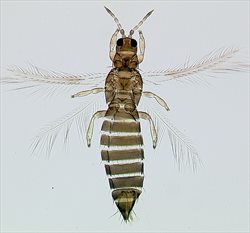
Female with tibiae unusually yellow

Head & pronotum

Antenna
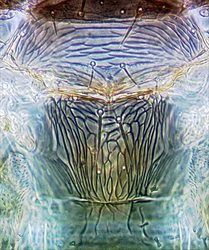
Meso & metanota
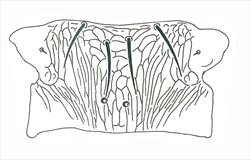
Metanotum

Pleurotergites II-III
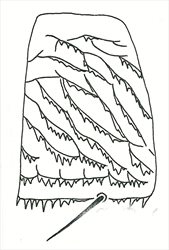
Pleurotergite II
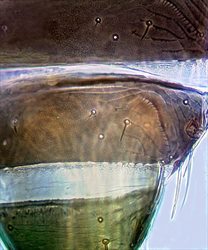
Female tergites VII-IX
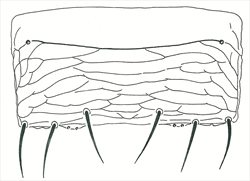
Female sternite VII
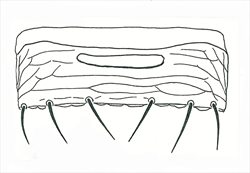
Male sternite V

Fore wing
Both sexes fully winged. Body and femora brown, tarsi and apices of tibiae almost yellow; major setae light brown; antennal segment III variably yellowish, IV light brown, V–VII brown; fore wings weakly shaded with base paler. Antennae 7-segmented; III–IV each with short forked sense cone, VII small. Head with 2 pairs of ocellar setae; pair III no longer than distance between 2 ocelli, arising on anterior margins of triangle; postocular setae pairs I & III slightly longer than ocellar setae III, postocular setae pair II very small. Pronotum with 2 pairs of posteroangular setae; posterior margin with 3 pairs of setae; discal area with widely spaced irregular transverse striae. Mesonotum with paired anterior campaniform sensilla; median setae arise well in front of posterior margin. Metanotum with irregular, longitudinal reticulation medially; median setae arising behind anterior margin; campaniform sensilla present. Fore wing first vein with 3 setae on distal half; second vein with 12–15 setae. Abdominal tergite II with 4 lateral marginal setae; tergites V–VIII with paired ctenidia, on VIII posteromesad to spiracles; tergite VIII posteromarginal comb absent medially, with several microtrichia laterally, discal setae S1 smaller than S2; pleurotergites with no discal setae, sculpture lines with weakly dentate microtrichia, posterior margin with few or no microtrichia; tergite IX with 2 pairs of campaniform sensilla, X with median split. Sternites with no discal setae; sternite I with 2–3 minute setae between hind coxae; sternite VII marginal setae S1 arise in front of margin.
Male smaller and paler than female; tergite VIII with no posteromarginal comb; tergite IX median setae slender, median pair arising in transverse row with lateral pair and posterior to campaniform sensilla; sternites III–VII with broad transverse pore plate.
The genus Thrips is the second largest genus in the Thysanoptera, and currently includes, worldwide, over 290 species. All members of genus Thrips lack ocellar setae I on the head, and they all have ctenidia on tergite VIII posteromesad to the spiracles. Other characters, such as number of antennal segments, number of setae on the fore wing veins, and number of discal setae on the sternites are variable between species (Palmer, 1992; Nakahara, 1994; Mound & Masumoto, 2005). Thrips fuscipennis is one of the most abundant flower thrips in Europe, and is a member of a group of species that are very similar in structure. These include menyanthidis, roepkei and sambuci, each of which has 4 lateral marginal setae on tergite II, the pleurotergites with a tendency to dentate rather than ciliate microtrichia, and a lack of teeth medially on the posteromarginal comb on tergite VIII.
Feeding and breeding on leaves and in the flowers of its host plants and, although polyphagous, often associated with species of Rosaceae.
Widely distributed and common throughout Britain from Kent to northern Scotland, and also from across the island of Ireland (Mound et al., 1976), this species occurs throughout the northern parts of the Palaearctic and is reported as far south as Iran. It is also known from North America, though there it is not as widely distributed as once thought (Nakahara, 1994).
THRIPIDAE - THRIPINAE
Thrips fuscipennis Haliday
Thrips fuscipennis Haliday, 1836: 448
Thrips meledensis Karny, 1908: 110
Thrips drabae Priesner, 1927: 369
Mound LA & Masumoto M (2005) The genus Thrips (Thysanoptera, Thripidae) in Australia, New Caledonia and New Zealand. Zootaxa 1020: 1–64.
Mound LA, Morison GD, Pitkin BR & Palmer JM (1976) Thysanoptera. Handbooks for the Identification of British Insects 1 (11): 1–79.
Nakahara S (1994) The genus Thrips Linnaeus (Thysanoptera: Thripidae) of the New World. United States Department of Agriculture. Technical Bulletin 1822: 1–183.
Palmer JM (1992) Thrips (Thysanoptera) from Pakistan to the Pacific: a review. Bulletin of the British Museum (Natural History) Entomology Series 61 (1): 1–76.